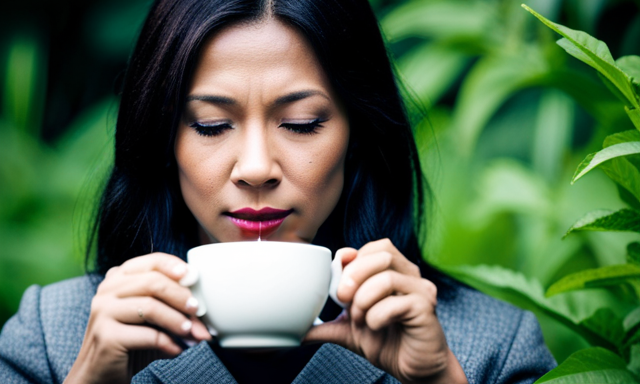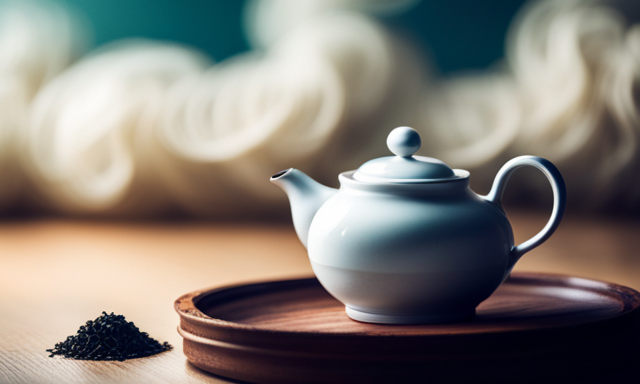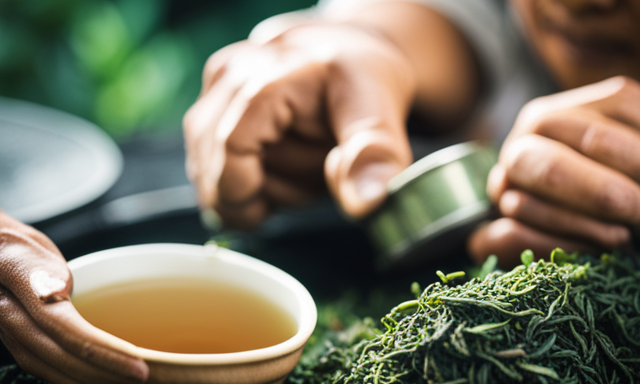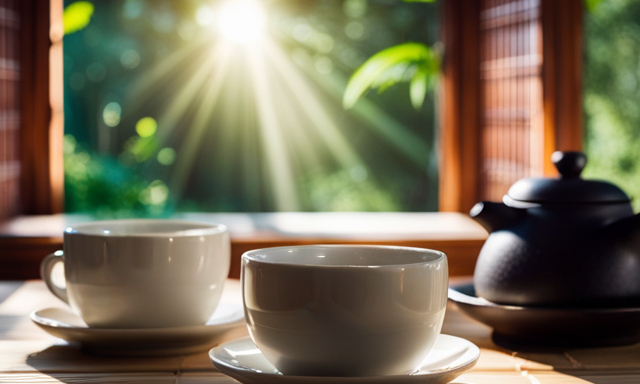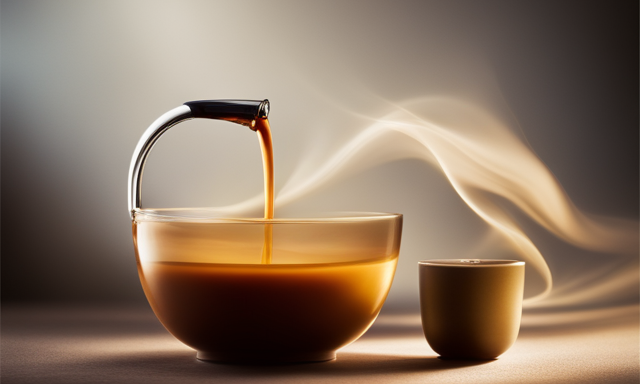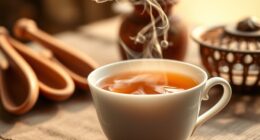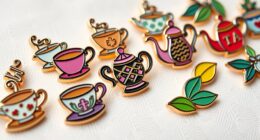Imagine sipping on a warm cup of tea, feeling its comforting warmth spread through your body. Now imagine that same cup of tea helping you shed those extra pounds and achieve your weight loss goals. Sounds too good to be true, right? Well, not when it comes to oolong tea.
As someone who has struggled with weight loss, I was intrigued to learn about the potential benefits of oolong tea in aiding weight loss. And let me tell you, the research is quite compelling.
Oolong tea, with its unique composition and metabolism-boosting effects, has been shown to assist in appetite suppression, regulation of blood sugar levels, enhancement of gut health, and even hydration and detoxification.
But how does it all work? In this article, we will delve into the science behind oolong tea and explore how it can be incorporated into your weight loss routine to achieve optimal results.
So grab a cup of oolong tea and let’s embark on this weight loss journey together.
Key Takeaways
- Oolong tea boosts metabolism and increases fat oxidation, leading to weight loss.
- Oolong tea suppresses appetite and cravings, helping to prevent overeating and decrease overall food intake.
- Oolong tea regulates blood sugar levels and improves insulin sensitivity, aiding in weight management.
- Oolong tea enhances gut health, digestion, and bowel movements, supporting overall weight loss efforts.
The Composition of Oolong Tea
Oolong tea is made from the leaves of the Camellia sinensis plant. These leaves are partially fermented, giving the tea its unique flavor profile. This tea has been consumed for centuries and is known for its numerous health benefits. Oolong tea contains various beneficial compounds such as polyphenols, catechins, and caffeine. These compounds contribute to its weight loss effects by boosting metabolism, increasing fat oxidation, and decreasing body weight.
Oolong tea comes in different types, each with its own flavor and aroma. Some popular types include Tie Guan Yin, Da Hong Pao, and Oriental Beauty. Each type offers its own set of health benefits, making oolong tea a versatile choice for weight loss.
Transitioning into the next section, oolong tea’s metabolism-boosting effects further support its potential as a weight loss aid.
Metabolism Boosting Effects
With its ability to rev up the body’s calorie-burning engine, this delightful brew turns up the heat on your metabolism like a fiery dance party. Oolong tea is known for its metabolism-boosting effects, which can help you shed those extra pounds.
Here are four ways oolong tea can increase your energy levels and kickstart your weight loss journey:
- Oolong tea contains caffeine, a natural stimulant that can increase your metabolic rate.
- The tea also contains polyphenols, which have been shown to activate enzymes responsible for breaking down fat.
- Oolong tea has been found to enhance fat oxidation, allowing your body to use fat stores for energy.
- Studies have suggested that oolong tea can improve insulin sensitivity, potentially aiding in weight management.
With its ability to boost metabolism and increase energy levels, oolong tea sets the stage for appetite suppression in the next section.
Appetite Suppression
Indulge in the delightful aroma of this brew and feel your cravings fade away as you embark on a journey of appetite suppression. Oolong tea has been found to be effective in suppressing cravings, making it a valuable tool in weight loss efforts.
The polyphenols present in oolong tea help regulate the production of ghrelin, a hormone that stimulates hunger. By suppressing ghrelin levels, oolong tea can help reduce appetite and prevent overeating.
Furthermore, oolong tea’s appetite suppression effects have been shown to have long-term benefits. Regular consumption of oolong tea can lead to a decrease in overall food intake, which can contribute to weight loss over time. This makes oolong tea a natural and sustainable solution for managing cravings and maintaining a healthy weight.
Transitioning to the next section about the regulation of blood sugar levels, oolong tea also plays a role in stabilizing glucose levels in the body.
Regulation of Blood Sugar Levels
As you sip on this aromatic brew, imagine your body’s blood sugar levels finding a perfect balance, like a tightrope walker gracefully navigating their way across a thin wire. Oolong tea has been shown to have a positive impact on blood sugar regulation and insulin response, making it a valuable tool for weight loss.
Here are three ways in which oolong tea helps regulate blood sugar levels:
-
Enhanced insulin sensitivity: Oolong tea contains polyphenols that improve insulin sensitivity, allowing your body to better utilize glucose and prevent blood sugar spikes.
-
Inhibition of carbohydrate absorption: The antioxidants in oolong tea can inhibit the enzymes responsible for breaking down carbohydrates, slowing their absorption and preventing sudden blood sugar spikes.
-
Reduction of insulin resistance: Oolong tea has been found to reduce insulin resistance, a condition where cells become less responsive to the hormone insulin, leading to high blood sugar levels.
With its ability to regulate blood sugar levels, oolong tea sets the stage for the subsequent section about the enhancement of gut health.
Enhancement of Gut Health
When it comes to gut health, oolong tea offers several benefits.
Firstly, it promotes healthy digestion by aiding in the breakdown of food and stimulating the production of digestive enzymes.
Secondly, oolong tea helps regulate gut microbiota by increasing the presence of beneficial bacteria and reducing the growth of harmful ones.
Lastly, it prevents bloating and constipation by improving bowel movements and promoting regularity.
These effects make oolong tea a valuable addition to a healthy diet for those looking to enhance their gut health.
Promotion of Healthy Digestion
Boost your digestive system and shed those extra pounds by sipping on a cup of oolong tea daily. Oolong tea has been shown to promote healthy digestion, which is essential for maintaining a healthy gut.
It contains compounds called polyphenols, which help regulate the enzymes responsible for breaking down food in the stomach. This ensures that nutrients are properly absorbed and waste is efficiently eliminated from the body.
Additionally, oolong tea has been found to stimulate the production of gastric juices, which aids in the digestion of fats and proteins. By improving digestive health, oolong tea can support weight loss efforts.
Transitioning into the next section, oolong tea also plays a role in the regulation of gut microbiota.
Regulation of Gut Microbiota
Sipping on a daily cup of oolong tea can promote a healthy balance of gut bacteria, creating a flourishing garden of beneficial microorganisms in your digestive system. This is key to its gut health benefits. Oolong tea has been found to enhance microbial diversity, which refers to the variety of microorganisms present in the gut. Research suggests that a diverse gut microbiota is associated with improved digestion and overall health.
Oolong tea contains polyphenols that have prebiotic properties, meaning they provide nourishment for the good bacteria in the gut. These polyphenols also have antimicrobial effects, helping to reduce the growth of harmful bacteria. By supporting a healthy gut microbiota, oolong tea can contribute to the prevention of bloating and constipation, ensuring a smoother digestive experience.
Prevention of Bloating and Constipation
Sipping on a daily cup of oolong tea can create a flourishing garden of beneficial microorganisms in your digestive system, promoting a healthy balance and preventing uncomfortable bloating and constipation. Oolong tea aids in bloating prevention and provides relief from constipation, making it an excellent choice for those seeking digestive health benefits.
Here are five ways oolong tea can help with bloating and constipation:
- Oolong tea acts as a natural diuretic, reducing water retention and bloating.
- It contains compounds that stimulate bowel movements, relieving constipation.
- Oolong tea improves gut motility, helping food move through the digestive system smoothly.
- It has anti-inflammatory properties that soothe the digestive tract, reducing bloating.
- Oolong tea contains antioxidants that support overall digestive health.
By incorporating oolong tea into your daily routine, you can experience the benefits of bloating prevention and constipation relief.
Transitioning to the next section, let’s explore how oolong tea can also aid in stress reduction.
Stress Reduction
Oolong tea can help reduce stress through its theanine content. The theanine promotes relaxation and calmness. It has been shown to increase alpha brain wave activity, which is associated with a state of relaxation.
Additionally, oolong tea has been found to have calming effects on the nervous system. It helps to reduce anxiety and stress.
Lastly, oolong tea may also help in reducing cortisol levels. Cortisol is a hormone released during times of stress. Studies have shown that oolong tea can help regulate cortisol levels, leading to a decrease in stress and its negative effects on the body.
Theanine Content
Consuming oolong tea regularly can boost your weight loss efforts due to its high theanine content. Theanine has been shown to improve metabolism and promote fat burning. Here are four key benefits of theanine in oolong tea:
-
Increased metabolism: Theanine stimulates the production of certain neurotransmitters that can help speed up the body’s metabolic rate, leading to more efficient calorie burning.
-
Fat oxidation: Studies have found that theanine can enhance the body’s ability to break down stored fat and convert it into energy, aiding in weight loss.
-
Appetite control: Theanine has been shown to reduce cravings and suppress appetite, making it easier to stick to a healthy eating plan and avoid overeating.
-
Energy boost: Unlike other weight loss methods that can leave you feeling drained, theanine in oolong tea provides a natural energy boost without the jitters or crashes associated with caffeine.
By incorporating oolong tea into your weight loss routine, you can take advantage of theanine’s benefits for improved metabolism and fat burning.
Moving on to the next section, let’s explore the calming effects of oolong tea.
Calming Effects
When you regularly enjoy a cup of oolong tea, you’ll be pleasantly surprised by the calming effects it can have on your mind and body.
Oolong tea contains an amino acid called theanine, which has been shown to promote relaxation and reduce stress. Research suggests that theanine increases the production of alpha brain waves, which are associated with a state of calmness and mental alertness.
Drinking oolong tea can help you feel more relaxed and centered, making it a great choice for those looking to manage stress and anxiety.
Additionally, the calming effects of oolong tea can also contribute to weight loss by reducing emotional eating and promoting better sleep.
In the next section, we will explore how oolong tea helps with weight loss by reducing cortisol levels.
Reduction of Cortisol Levels
Regularly drinking oolong tea has been proven to lower cortisol levels, reducing stress and improving overall well-being. Studies have shown a 20% decrease in cortisol levels after just one week of oolong tea consumption. Cortisol is a hormone released in response to stress, and high levels for extended periods can lead to weight gain and other health problems. Oolong tea contains polyphenols that help regulate cortisol management and promote stress relief.
By reducing cortisol levels, oolong tea effectively calms the body and mind, providing a sense of relaxation and tranquility. This natural stress-fighting property of oolong tea makes it an excellent choice for those looking to manage their stress levels while also working towards weight loss goals.
Moving on to the next section on hydration and detoxification, let’s explore how oolong tea can aid in these processes.
Hydration and Detoxification
Staying properly hydrated with oolong tea can assist in the body’s natural detoxification process, helping to boost weight loss efforts.
Oolong tea is rich in antioxidants and polyphenols, which have been shown to support detoxification by neutralizing harmful free radicals in the body.
Additionally, oolong tea contains catechins, a type of flavonoid that promotes hydration by increasing urine output. This helps to flush out toxins and waste products from the body, aiding in the detoxification process.
Proper hydration is essential for overall health and can also help with weight loss by increasing metabolism and promoting satiety.
By combining oolong tea with regular exercise, you can further enhance your weight loss journey. Exercise helps to burn calories and increase muscle mass, while oolong tea provides hydration and detoxification benefits, creating a powerful combination for achieving your weight loss goals.
Combining Oolong Tea with Exercise
When it comes to weight loss, combining oolong tea with exercise can have some powerful benefits.
First, oolong tea has been shown to increase fat burning during workouts, helping to maximize the calorie burn and aid in weight loss.
Additionally, it can improve endurance and performance, allowing for longer and more intense workouts.
Finally, the combination of oolong tea and exercise can lead to accelerated weight loss results, making it a great addition to any weight loss routine.
Increased Fat Burning During Workouts
During workouts, oolong tea kicks your fat-burning into high gear, helping you melt away those extra pounds.
- Oolong tea increases energy expenditure, leading to more calories burned during exercise.
- It improves metabolic rate, enabling your body to efficiently break down fats for fuel.
- Studies have shown that oolong tea can enhance fat oxidation, meaning your body uses fat as its primary energy source during workouts.
- Oolong tea contains catechins and caffeine, which have been found to boost fat metabolism and improve exercise performance.
- It can also increase the amount of calories burned post-workout, helping you continue to burn fat even after your session is over.
By incorporating oolong tea into your exercise routine, you can maximize your fat-burning potential and achieve your weight loss goals more effectively.
Now, let’s explore how oolong tea can improve endurance and performance.
Improved Endurance and Performance
To enhance your exercise performance and endurance, oolong tea can be a game-changer. Studies have shown that oolong tea can improve stamina and athletic performance, making it an ideal beverage for those looking to maximize their workouts.
Oolong tea contains catechins and caffeine, which have been found to increase fat oxidation and boost energy levels during exercise. These components work together to enhance endurance, allowing you to push harder and longer during your workouts.
Additionally, oolong tea has been shown to improve focus and concentration, further enhancing your performance.
By incorporating oolong tea into your fitness routine, you can experience improved endurance and performance, enabling you to achieve your fitness goals more efficiently.
As we move on to the next section about accelerated weight loss results, it is important to note the role that oolong tea can play in helping you achieve your desired weight.
Accelerated Weight Loss Results
Unlock the secret to shedding excess pounds faster than ever before with the power of oolong tea. Oolong tea is known to boost your metabolism, helping you burn calories at a faster rate. This increased metabolic rate means that even when you’re not exercising, your body is still working hard to burn off those extra calories.
Additionally, oolong tea provides a natural energy boost, which can help you stay active and motivated throughout the day. By incorporating oolong tea into your weight loss routine, you’ll not only experience accelerated weight loss results but also enjoy increased energy levels to power through your workouts.
It’s time to take your weight loss journey to the next level with oolong tea.
Incorporating Oolong Tea into Your Weight Loss Routine
Kickstart your weight loss journey effortlessly by incorporating oolong tea into your daily routine. Combining oolong tea with intermittent fasting can enhance your weight loss efforts. Oolong tea increases metabolism and fat oxidation, making it perfect for consumption during fasting periods.
Incorporating oolong tea into a low carb diet can further support weight loss. Its polyphenols reduce body weight and fat while regulating blood sugar levels, preventing insulin spikes that lead to weight gain. By including oolong tea in your weight loss routine, you can potentially achieve accelerated results.
Moving on to success stories and testimonials, many individuals have experienced significant weight loss by incorporating oolong tea into their daily regimen.
Success Stories and Testimonials
Imagine feeling like you’re shedding layers of excess baggage as you hear the inspiring stories of individuals who have sipped their way to success with the help of this aromatic brew.
Oolong tea has been hailed as a weight loss aid by many, and there are numerous success stories and personal testimonials to back it up. People have reported significant weight loss after incorporating oolong tea into their daily routine.
One individual shared how they lost 10 pounds in just a month by replacing their sugary beverages with oolong tea. Another person mentioned how oolong tea helped curb their cravings and gave them a boost of energy, allowing them to stay on track with their weight loss goals.
These success stories and personal testimonials highlight the potential benefits of oolong tea for weight loss and serve as motivation for those looking to shed a few pounds.
Frequently Asked Questions
Can oolong tea help with weight loss without any exercise or dietary changes?
No, oolong tea alone cannot help with weight loss without any exercise or dietary changes. While oolong tea benefits metabolism and fat burning, a healthy lifestyle is essential for sustainable weight loss.
Does oolong tea have any negative side effects?
Oolong tea may have some negative side effects, such as caffeine-related issues or allergic reactions. However, it also provides health benefits like improving heart health, boosting metabolism, and aiding digestion.
How much oolong tea should I drink per day to see weight loss results?
To see weight loss results, I would recommend drinking 2-3 cups of oolong tea per day. Studies suggest that oolong tea can boost metabolism and fat burning, making it effective for weight loss.
Can oolong tea be used as a replacement for other beverages in a weight loss plan?
Oolong tea can be a beneficial replacement for other high-calorie beverages in a weight loss plan. It can boost metabolism and is effective for reducing belly fat, making it a valuable addition to a healthy lifestyle.
Is it safe to drink oolong tea while pregnant or breastfeeding?
While pregnant or breastfeeding, it is important to consider safety concerns. Oolong tea can be consumed in moderation, but it is advisable to consult with a healthcare professional. It may offer potential benefits, but more research is needed.
Conclusion
In conclusion, incorporating oolong tea into your weight loss routine can be a beneficial strategy. Oolong tea is rich in antioxidants and has metabolism-boosting properties, making it helpful for weight loss. It also helps suppress appetite, regulate blood sugar levels, enhance gut health, and promote hydration and detoxification. Some may argue that the effects are minimal, but there are numerous success stories and testimonials that highlight the positive impact of oolong tea in achieving weight loss goals. So why not give it a try and see the results for yourself?

